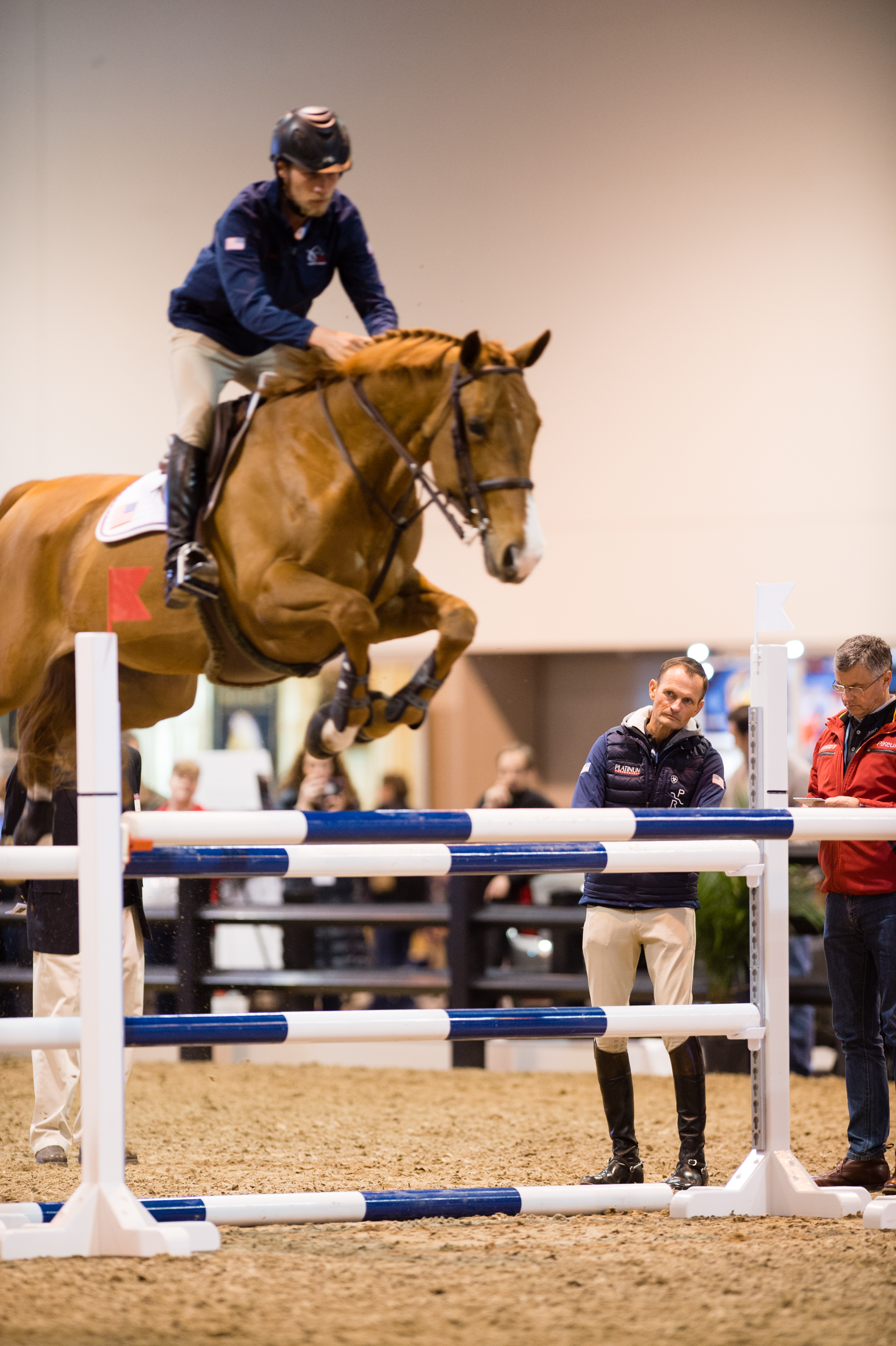
Eric Navet’s soft hand, fluid body position and lack of interference with his horses epitomize a classic, quiet riding style. On course, “The horse should forget me,” the French champion jumper rider explains. But it’s more like a partnership found in a long marriage, where the spouses know each other so well they don’t need words or actions to understand what’s expected.
Eric’s method for attaining that kind of relationship with his horses is old-fashioned and rooted in flatwork. He’s a third-generation horseman, who grew up riding for his father Alain Navet’s breeding program in Normandy, France. It was the family’s livelihood, which meant the potential in every horse had to be found and developed.
“We had no choice but to try to make every single horse better,” explains Eric, whose many competitive accomplishments include victories that span from 1990 individual and team gold medals to 2002 team gold and individual silver medals at the World Equestrian Games. “I’ve always considered it my job to communicate with the horse and make a commitment to get to know him better. The main skill for a rider is to be able to listen to his horse and to understand. They have their way of talking to us.”
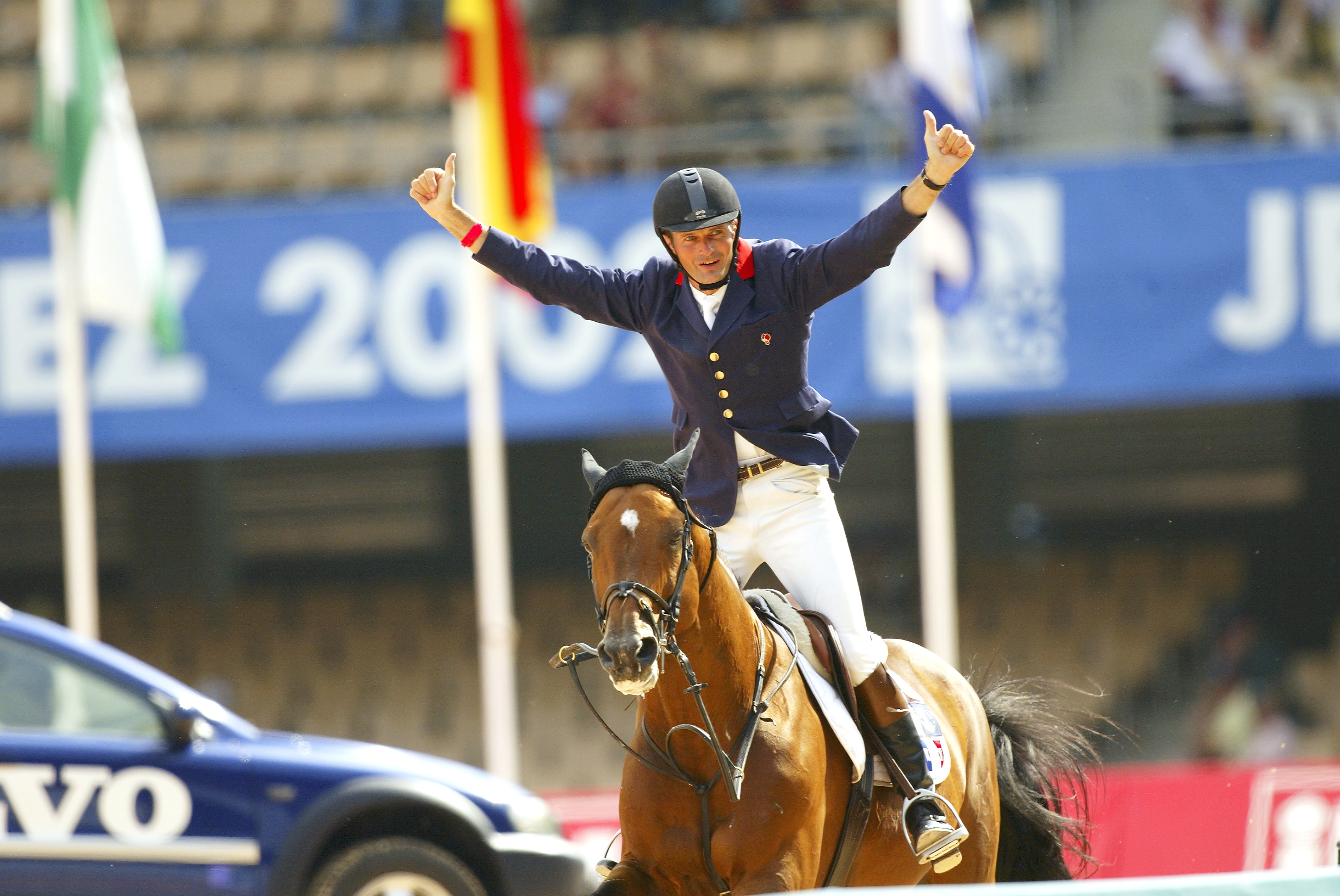
Eric moved to California in 2013 to be the personal coach for young grand prix rider Karl Cook. Karl contested the Longines FEI World Cup™ Jumping Final in 2015 aboard Jonkheer Z and qualified again on Tembla in 2016 and 2017, but competitive accomplishments are only one reflection of the success of his and Eric’s partnership.
After earning North American Junior and Young Rider Championship individual and team gold medals as a junior, Karl later embarked on a knowledge quest that led him to Eric’s farm in France in 2012. Fast forward five years and Eric and Karl are the collaborative crux of Pomponio Ranch, mixing old-fashioned horsemanship with Karl’s penchant for looking beyond the sport and outside the box for new ways to enhance those methods.
Cutting-Edge Ideas
After watching a TED Talk, about spaciotemporal pattern recognition (featured in “The Math Behind Basketball’s Wildest Moves”), Karl wondered about using the concept to evaluate equine jumping form to predict a young horse’s capabilities and to analyze changes in form and their cause for current campaigners. The Pomponio team began its research at 2016 HITS Thermal, affixing sensors to several points on the horse, then using infrared motion capture to record him going through a gymnastic jumping exercise repeatedly.
It’s “way, way, way” too soon to have made sense of the collected data, let alone figure out how to apply it, but it’s a start, Karl explains. And it’s an example of his desire to think differently about horses and horse sports.
Eric and Karl agree that understanding and tending to the horse’s physical state is critical to effective communication between horse and rider. At Pomponio Ranch, that effort is led by French international veterinarian Philippe Benoit, brought on board in 2013 just as Karl was enthusiastically shifting from rider to horseman at Eric’s urging.
Dr. Benoit is on site at Pomponio’s San Diego, California, location or with Eric and Karl on the competition circuit, observing everything: flat sessions, jump schools and grand prix rounds. He designed and supervises a cutting-edge equine sports-medicine regimen that analyzes everything from regularly scheduled blood draws to whether the horse’s shoes are the best fit for the footing. He’s joined in this monitoring by his wife, Kate Zukiewicz-Benoit. A veterinarian who specializes in physical therapy and acupuncture, she watches the horses at work, rest and play to determine what type and frequency of bodywork would best improve their comfort and performance or help them recover from an injury.
Everything they do circles back to the goal of understanding, says Karl, echoing his teacher. In developing a young horse or refining a veteran, “It’s that horse and rider have to understand each other. When you’re on course, they have to understand that if Eric moves his body this way, a certain thing has to happen.”
And it has to happen fast. “The sport of show jumping has changed a lot,” observes Eric. “There is so much need for precision and rideability, so what we need is more understanding from the horse and training for better communication between the horse and rider. If the horse is not totally focused on the rider when you land from one fence, then it’s too late for the next fence. You need to get that now, not two strides later. That’s too late.
“It’s a long process,” Eric continues. “People who want to be quick in the training fail. It’s about patience, and every day there is a commitment to install a code between the horse and rider.”
Force has no part in that code. “Look at me,” says the 58-year-old Eric of his slight, fit build. “It’s not that I’m physically stronger than the other rider.”
The code ensures that, “If the horse has to shorten his stride on course, he will do it not because he is forced to do it but because that language between horse and rider has been established.” Too often, Eric notes, horses fail because they’re confused about what’s expected of them.
Coercion has no place either. “A good horse wants to jump and a successful horse enjoys jumping,” Eric states. Keeping it enjoyable is the rider’s responsibility and it starts with putting himself in the horse’s shoes. “If you start your warm-up by putting the horse’s chin in his chest, how can a horse enjoy that?” Eric asks. “I am always telling Karl, ‘If you were the horse, would you be happy with your rider?’”
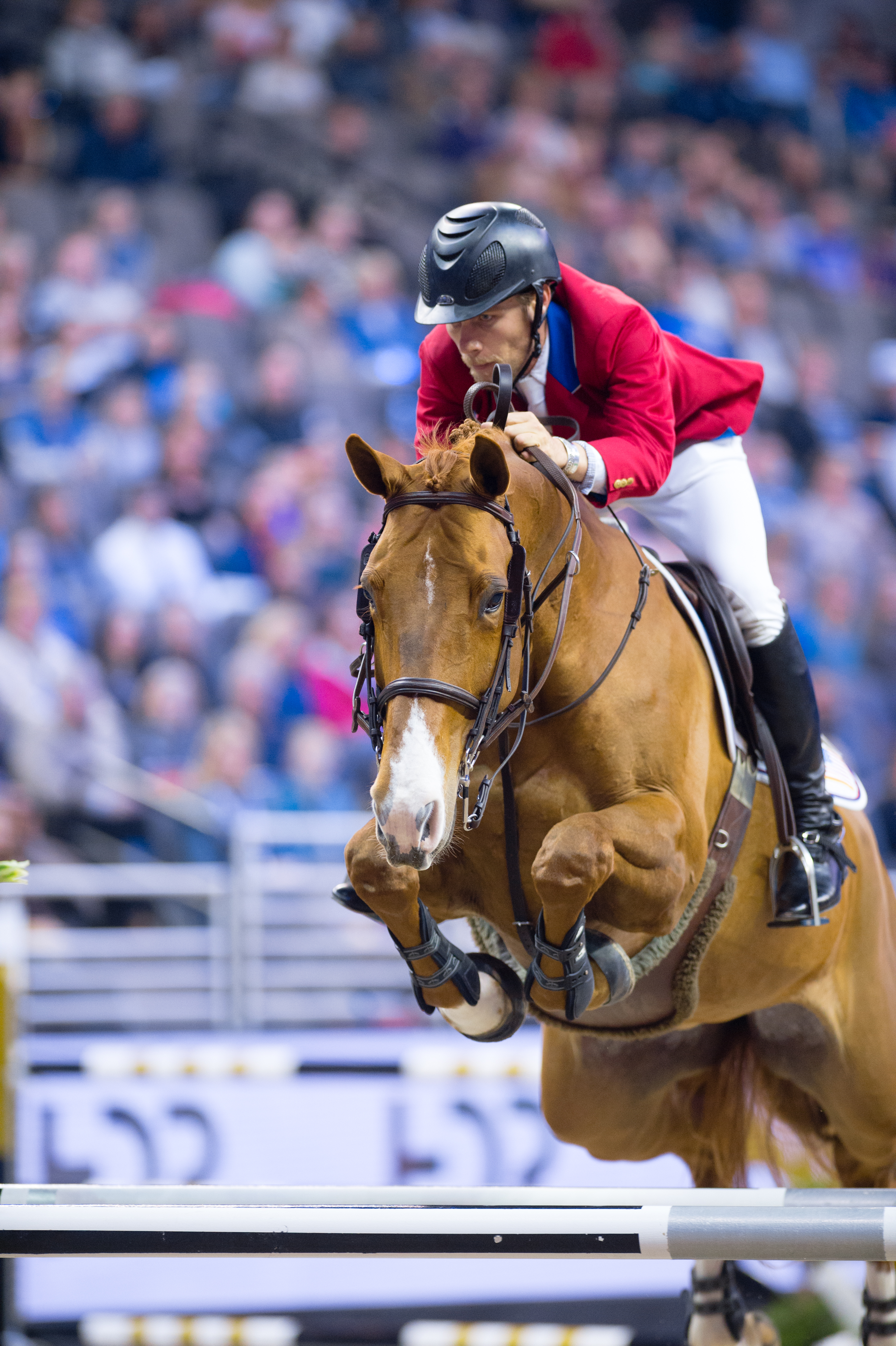
Patience: More Than A Virtue
The Cook family’s commitment to patience in horse development is a major reason Eric agreed to move to the United States as Karl’s private coach and take on the informal title of “rider in chief” for Pomponio Ranch. Eric’s wife, Ursula, and their two high-school-age daughters, Estelle and Laurén, made the move in the summer of 2013, too. They’re all riders and keep and campaign their own horses based out of the Cook’s stable. Karl and his parents never put any pressure regarding the time it takes to develop a horse,s Eric explains. “They know that I am a horseman and they trust me.”
Patience is important in daily work. “I never go faster than the understanding of the horse,” Eric says. And it plays out on the grander scale of skipping major competitions if that’s best for the horse.
For example, Eric was selected for France’s Sydney Olympics team in 2000 with Dollar du Murier Hauts de Seine. “I considered the horse was not ready, so I didn’t join the team. But two years later, we represented France in the World Equestrian Games and won team gold and individual silver on the same horse. I’m sure that if I had gone to the Sydney Olympics, we would not have been successful and I would not have gone on to the WEG. You have to know your horse and have people around you that trust your opinion.”
Karl had exactly those kind of people around him when it came time to decide on the 2016 Longines FEI World Cup™ Jumping Final in Gothenburg, Sweden. He and his Zangershiede mare Tembla won the 2015/2016 Longines FEI World Cup™ Jumping North American Western Sub-League, but he and Eric felt she wasn’t ready for the intensified rigors of the Final. “The qualifying process is nothing like the Final,” Karl notes. “It’s a big step. The fences are larger, wider and they come up quicker.
“Horses enjoy their job because they understand it,” Karl continues. “When we as riders get too focused on our goals, we forget the importance of that.”
Eric and Karl acknowledge the luxury of never being pressured by owners to push the pace of a horse’s development. Still, skipping the Final wasn’t an easy decision. “There was a lot of work and disappointment that went into making that call,” Karl says. In the end, the horse’s readiness for a big competition “is not something you should wonder about.” So they stayed home.
Not so this year. “Tembla is much more mature,” says Eric. “We feel comfortable to give it a try. Even if it doesn’t go well, we don’t think it’s going to destroy anything about the mare.” Karl and the 13-year-old Tembla had some challenges in the first round of the Final and he opted to retire and compete in the less-demanding International Omaha Jumping Grand Prix Saturday night, where they had a confident fault-free first round and four faults in the jump-off to finish fourth.
Eric hadn’t intended to tackle the Final on the 10-year-old Hanoverian Catypso, but they accumulated 28 points throughout the 2016/2017 Longines FEI World Cup™ Jumping North American League season. Over the last four years, the quirky horse matured faster than Eric expected.
They finished 19th in the Final and Eric could not have been more thrilled with his horse. “Technically, I knew he was ready,” he explains. “What I was a little concerned about is that he didn’t have the experience at that level and in those conditions before. We have only three indoor classes on the fall circuit and we had just come from such a huge outdoor ring at Thermal. But knowing that he had the technique and the scope is what helped me decide to go. The good thing was he really let me ride him and made it easy for me to show him in a very difficult class. He learned so much and jumped better and better every day.”
Eric says Catypso had an edge over Tembla in the new and electric environment because “he has no emotions,” whereas “she is very emotive. She can freak out and that’s what happened because she needed to discover these conditions.” Tembla and Karl’s comeback in the grand prix also made Eric proud. “It could have been a bad experience, but they were fantastic in the grand prix. It wound up being a great experience for both horses.”
With the Longines FEI World Cup™ Final slated to be in Paris next year, Eric says he and Karl are targeting a return to his home country. And in Catypso’s first competition back after the World Cup, he and Eric won the $130,000 Hollow Creek Farm CSI*** Grand Prix in Lexington, Kentucky in May.
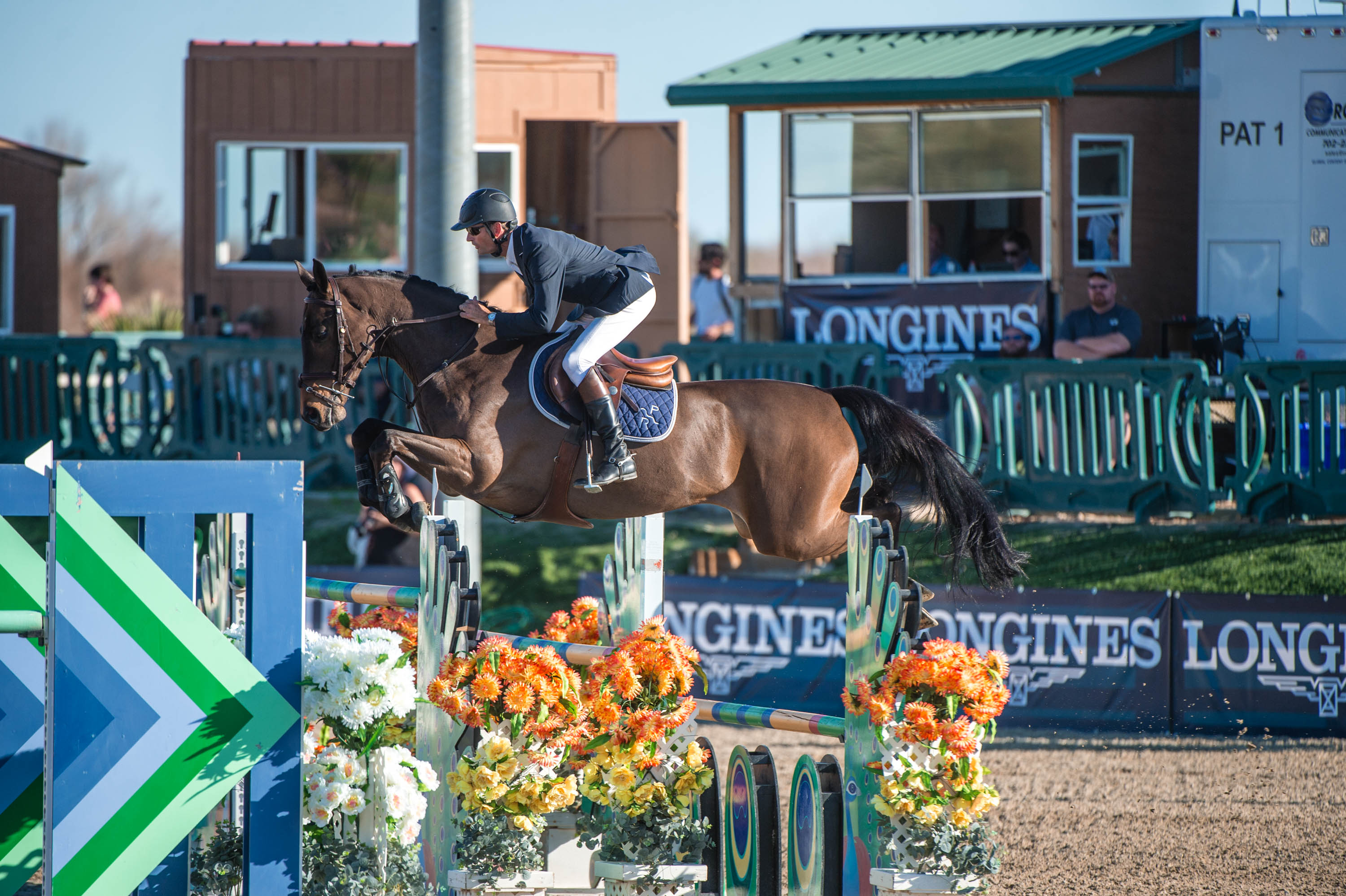
Longitudinal Management
Pomponio horses of all ages benefit from what veterinarian Philippe Benoit calls a “longitudinal” approach to managing their health and happiness. It entails repeated observation of the same details over a long period of time.
Where a more typical relationship with clients puts the vet in a “fireman’s role of putting out fires,” Dr. Benoit can focus on injury prevention and performance enhancement. He monitors a myriad of measurable physical details and combines that information with his own observations and those of people caring for and riding the horses. Dr. Benoit produces weekly, monthly and annual reports on each horse. Daily exams are part of the grooms’ routines.
“We look at everything: nutrition, forage, shoeing, is the shoeing right for the footing, tack, saddle fitting, what we see in the barn and what we see or feel under saddle,” Dr. Benoit explains. Blood analysis, pulse and respiratory rate at rest, after schooling and after competition are among the details tracked and examined.
This kind of monitoring is the norm with elite human athletes and somewhat so for equine athletes in top programs internationally. It helps reduce the need for medications and injections and provides the necessary information to create individualized programs for each horse. One example is having a different warm-up routine. “Maybe one horse you want to rub his hock for a while and another should be stretched in a certain way before he’s ridden,” Karl suggests. “One horse might want to walk around the property, another wants to get in the ring and trot right away.”
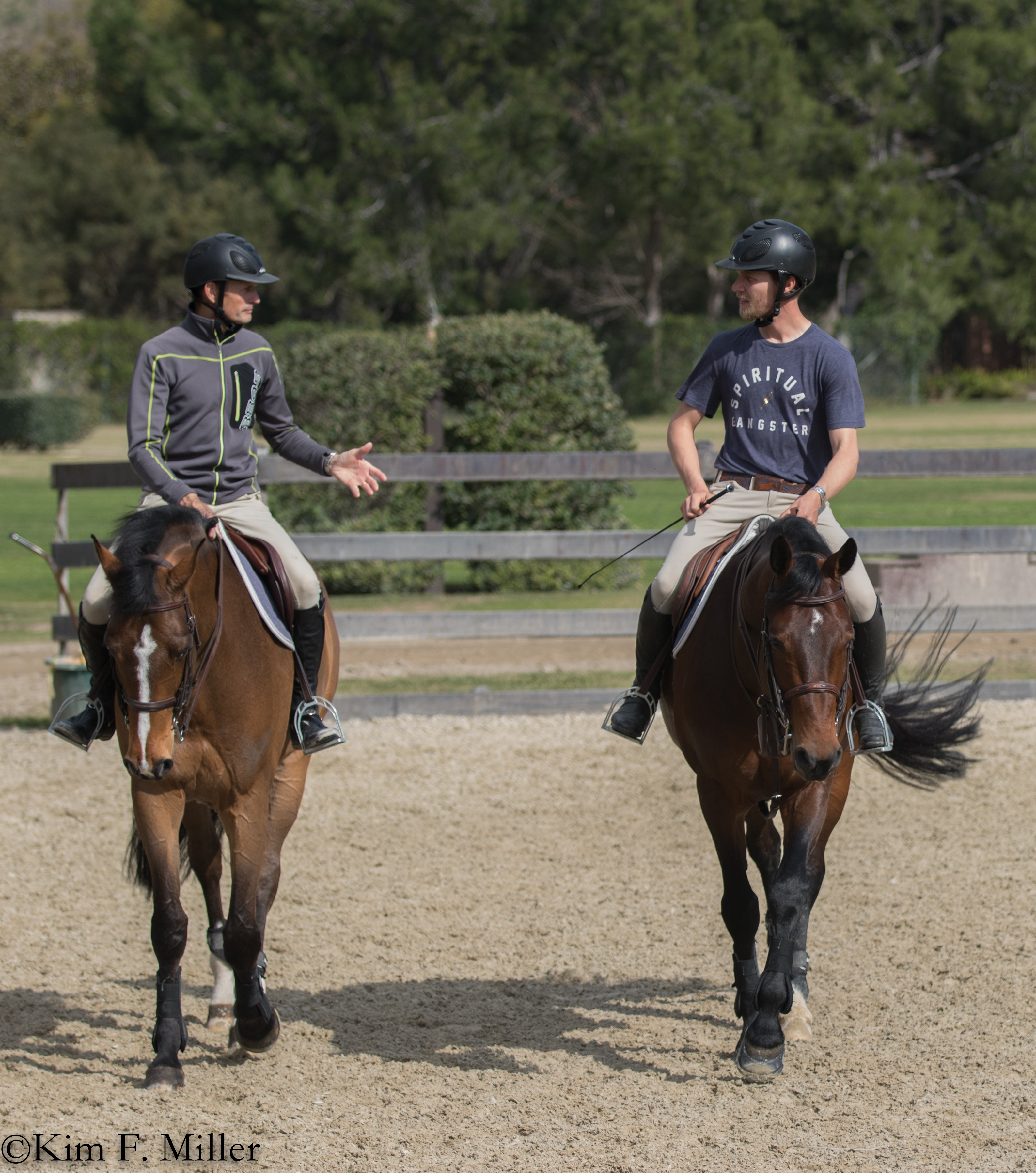
The amount of data gathered and monitored by the Pomponio team exceeds the capacity of standard stable-management software. They looked beyond the horse world to find Basecamp, a program designed for individual project management in the corporate world. Its flexibility and expandability were just what they needed and now the whole team has cloud-based access to inputting and following information on every horse in the program.
As in the jumping-form study, gathering information is one thing and applying it is another. “With a lot of the stuff we are doing, it takes a while to figure out how it can apply to the general public,” Karl acknowledges. He sees a parallel in the Formula 1 car-racing industry, where in 1993 a car manufacturer developed technology that controlled a car’s center of gravity in a way that enables turning at a faster speed. “It got banned because it was too good,” Karl explains. “But in 2000, you were starting to see it used in luxury cars.” He hopes Pomponio’s studies and experiments will have similar long-term benefits for horse sports.
Karl’s forward-thinking approach is not surprising given his lineage. His father, Scott Cook, founded the software giant Intuit and his mom, Signe Ostby, is an accomplished entrepreneur in the software and marketing world.
The Pomponio team hopes the infrared motion-capture jumping study will reveal helpful patterns: for example, how a horse is pushing off for the jump, whether the push is coming equally from both sides or if one side is pushing more than the other. Combined with the many other pieces of information Pomponio is monitoring, it could help detect physical issues in their earliest and most treatable stages.
The study is the technology-assisted component of a quest that started with Eric’s first days in his father’s yard: understanding the horse. It’s a lesson that’s clearly been embraced by his student.
“On the practical side, people want to look at this study as a way to find lamenesses and know where to treat them,” Karl says. “It has great potential for that, but let’s back way, way up to the question of what are we learning as a rider and how can we apply it. At the end of the day, it’s all about good horsemanship with patience and an understanding of the horse. It’s not just riding, it’s learning and paying attention to feel or see something. We should try to keep it that simple.”
Bringing Along Babies
Fulfilling 26-year-old Karl Cook’s international goals is priority one for the Pomponio Ranch program. Since Karl and Eric Navet teamed up, buying young horses and bringing them along in their own way has produced the most compatible partners. Bringing homebreds along is the next goal, both as prospective grand prix partners for Karl and as sales horses for various levels of the American market.
Karl’s mother, Signe Ostby, a rider herself and longtime sport supporter and advocate, launched Pomponio Ranch Stallions in 2011 and it’s now home to six stallions and a small band of high-quality mares. Located on 2,700 acres in a remote area near Northern California’s Half Moon Bay, Pomponio Ranch also raises Angus and Akaushi cattle and Heritage pigs plus Alpaca sheep for another of Signe’s passions: knitting.
Pomponio Ranch Stallions produces an average of five or six babies a year, the oldest of which is 6-year-old Leonidas PR, a grand prix prospect by ASB Conquistador. The handsome bay gelding recently moved south to San Diego for regular work with Karl and Eric.
In addition to ASB Conquistador, Pomponio’s current sire roster includes the Belgian Warmblood Elite stallions Uno de Laubry, Karl’s 2007 NAJYRC individual and team gold partner, and his 2015 FEI World Cup™ Final mount Jonkheer Z, campaigned by Guy Thomas. Numerous victories in breed inspections and jumper futurity competitions validate Pomponio’s marketing pitch to breed to “proven champion stallions.”
This article was originally published in the July 2017 issue of Practical Horseman.










